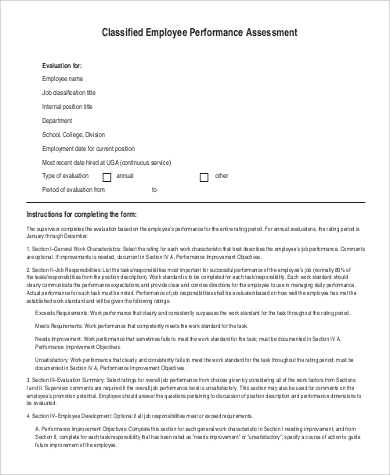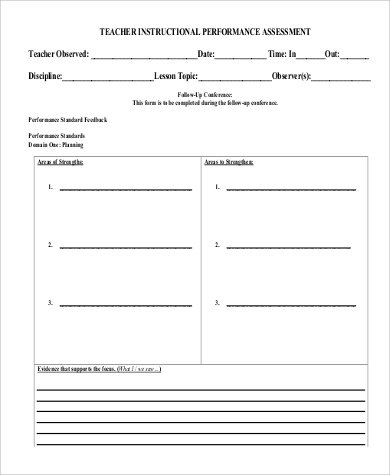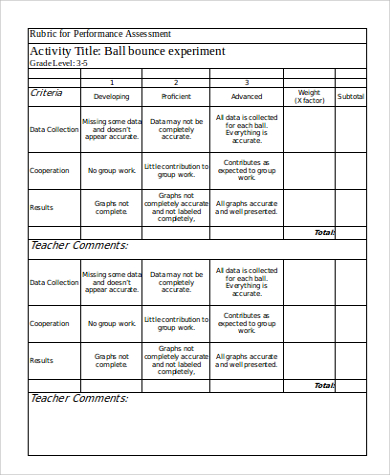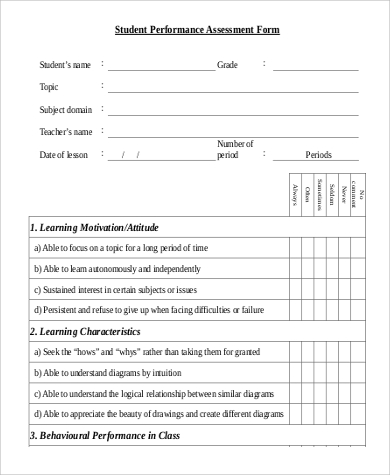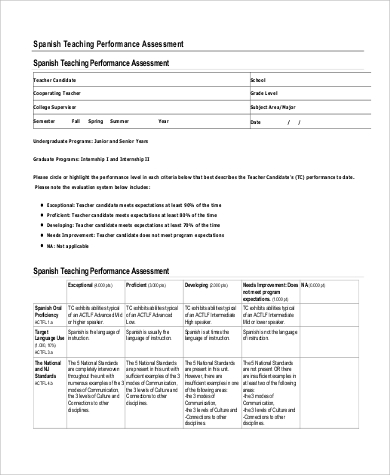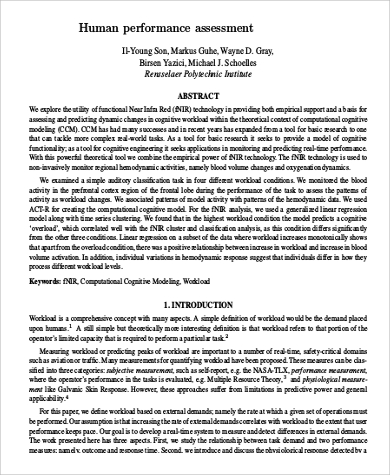Most people perceive evaluations as a means of testing and find it a tedious and hassling process. An evaluation, however, is a constructive tool in order for an individual or an organization to calibrate its performance level and determine ways to improve an individual’s set of skill and to better an organization’s quality of service.
A smart employer knows that a company is fueled by its employees. Employees who perform well are able to deliver positive results. Good and positive results are an effect of good management handling, and good management handling is the outcome of carefully made decisions that come from credible information and documentation.
Employee Performance Assessment Example
Teacher Instructional Performance Assessment Sample
Rubric for Performance Assessment in Word
Student Performance Assessment Form Sample
Teaching Performance Assessment Form in PDF
A performance evaluation is a periodic assessment that is done to determine an employee’s capacity, capability, achievements, skills, strengths, and weaknesses. With the help of a performance evaluation, management can easily assess an employee’s performance and figure out ways to improve weaknesses and retain strengths. Below is a more detailed outline of the benefits that you reap from performance evaluations:
Points Out Strengths and Weaknesses
Periodic job performance evaluations at work gives managers a chance to properly and critically assess a worker’s strengths and weaknesses. Through this process, managers can help employees develop their strengths and work on their weaknesses. This also allows employers to profile employees accordingly so that they can be assigned to teams or departments that allow them to maximize their potentials.
Basis for Promotions and Salary Increase
Most companies conduct job performance evaluations as a basis for an employee’s promotion or salary increase. Most managers document the results of an evaluation to serve as supporting details or references for when the employee is being profiled for bigger responsibilities or an increase in wages.
Gives a Chance to Work on Ways for Improvement
Through performance evaluations, employers or managers will be able to conduct training and development programs to help employees improve. A career development training is an example of a developmental program that an employer can provide to improve employee performance.
Pre-service Performance Assessment Form Sample
Standard Partner Performance Assessment
Integrated Performance Assessment Sample
Human Performance Assessment in PDF
Model-Based Performance Assessment to Download
Conducting an effective job performance evaluation takes careful observation and proper documentation. Below is a step-by-step process on how to conduct an effective and constructive job performance evaluation in the workplace.
- Set Standards and Goals
Before you can accurately evaluate an employee’s performance level, you must first accomplish a set of standards and goals that the employee has to meet in order to pass. Your standards have to be the type of performance you want an employee to accomplish while your goals should be tailored to what each employee is capable of.
- Document an Employee’s Work Performance
Keep track of an employee’s work performance such as his achievements and any disciplinary action that was given to the employee for misconduct. Documenting these instances will help you properly evaluate an employee’s character and abilities.
- Provide Feedback
A job performance evaluation would be useless without feedback. Periodically, a manager has to set aside time to organize results of the evaluations he has conducted and discuss the results to his employees one by one. During the discussion, point out his strengths—let your employee know that you appreciate him for the good contributions he has brought to the company. Afterward, point out his weaknesses and ask him on ways to help him improve in a particular area. Finally, a manager can then offer suggestions and give out target goals to help the employee improve on his weak spots.
You can use our assessment forms in order for you to properly document your evaluations. Save yourself from the inconvenience of having to construct an assessment form from scratch. Download our Sample Assessments, Business Risk Assessment, Project Risk Assessments.
Related Posts
FREE 10+ Joint Assessment Samples [ Strategic, Risk, Needs ]
FREE 10+ Teleworker Self-Assessment Samples in PDF | DOC
FREE 10+ Market Assessment Samples in PDF | MS Word
FREE 10+ Quality Risk Assessment Samples [ Control, Assurance, Management ]
FREE 6+ Immediate Termination of Lease Agreement Samples in MS Word | Google Docs | Apple Pages | PDF
FREE 10+ Qualitative Risk Assessment Samples in PDF | DOC
FREE 10+ Comprehensive Needs Assessment Samples in PDF
FREE 10+ Evaluation Quality Assessment Samples [ Self, Loss, Data ]
FREE 10+ Promotion Assessment Samples [ Health, Self, Employee ]
FREE 10+ Environmental Impact Assessment Samples in PDF | DOC
FREE 10+ Employee Competency Assessment Samples in PDF | DOC
FREE 10+ Safety Assessment Samples [ Home, Health, Risk ]
FREE 10+ Change Impact Assessment Samples [ Management, Control, Request ]
FREE 10+ Qualitative Assessment Samples in PDF | DOC
FREE 10+ Staff Assessment Samples [ Workplace, Health, Risk ]
